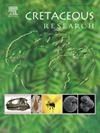A New Fossil of Cystodium (Cystodiaceae) from the mid-Cretaceous Myanmar amber
IF 1.9
3区 地球科学
Q1 GEOLOGY
引用次数: 0
Abstract
The only known fossil of Cystodium (Cystodiaceae) is C. sorbifolioides from mid-Cretaceous Myanmar amber. Here we describe a new fossil species of Cystodium, C. parasorbifolium, also from amber collected in Myanmar. This new species belongs to Cystodium based on pinnate fertile lamina segments, terminal sori protected by a reflexed lobe of the lamina (outer or false indusium), free veins, vertical annuli interrupted at the stalk, trilete spores, and striate perines. It differs from C. sorbifolioides by reflexed ovate-conical indusia and spores with clear striate perines. This new fossil species suggests that Cystodium was more diverse in the forests of Myanmar during the Cretaceous.
白垩纪中期缅甸琥珀中发现的一种新的尾柱孢属化石
唯一已知的鞘状石化石是来自白垩纪中期缅甸琥珀中的C. sorbifolioides。在这里,我们描述了一个新的Cystodium化石物种--C. parasorbifolium,它也来自缅甸的琥珀。该新种属于子囊菌(Cystodium),其特征包括羽状可育薄片裂片、由薄片的反折裂片(外侧或假indusium)保护的顶端裂片、游离的叶脉、在柄部中断的垂直环纹、三列孢子和具条纹的被毛。它与 C. sorbifolioides 的不同之处在于反折的卵状圆锥形压头和具有清晰条纹状被膜的孢子。这一新化石物种表明,白垩纪时期缅甸森林中的子囊菌种类更为丰富。
本文章由计算机程序翻译,如有差异,请以英文原文为准。
求助全文
约1分钟内获得全文
求助全文
来源期刊

Cretaceous Research
地学-地质学
CiteScore
4.10
自引率
19.00%
发文量
235
审稿时长
12 weeks
期刊介绍:
Cretaceous Research provides a forum for the rapid publication of research on all aspects of the Cretaceous Period, including its boundaries with the Jurassic and Palaeogene. Authoritative papers reporting detailed investigations of Cretaceous stratigraphy and palaeontology, studies of regional geology, and reviews of recently published books are complemented by short communications of significant new findings.
Papers submitted to Cretaceous Research should place the research in a broad context, with emphasis placed towards our better understanding of the Cretaceous, that are therefore of interest to the diverse, international readership of the journal. Full length papers that focus solely on a local theme or area will not be accepted for publication; authors of short communications are encouraged to discuss how their findings are of relevance to the Cretaceous on a broad scale.
Research Areas include:
• Regional geology
• Stratigraphy and palaeontology
• Palaeobiology
• Palaeobiogeography
• Palaeoceanography
• Palaeoclimatology
• Evolutionary Palaeoecology
• Geochronology
• Global events.
 求助内容:
求助内容: 应助结果提醒方式:
应助结果提醒方式:


